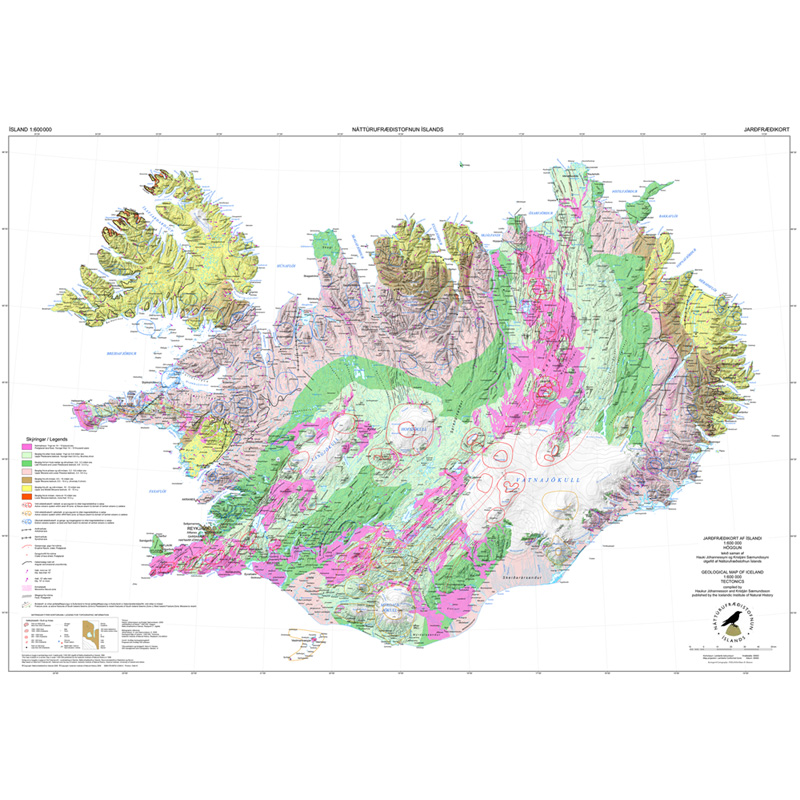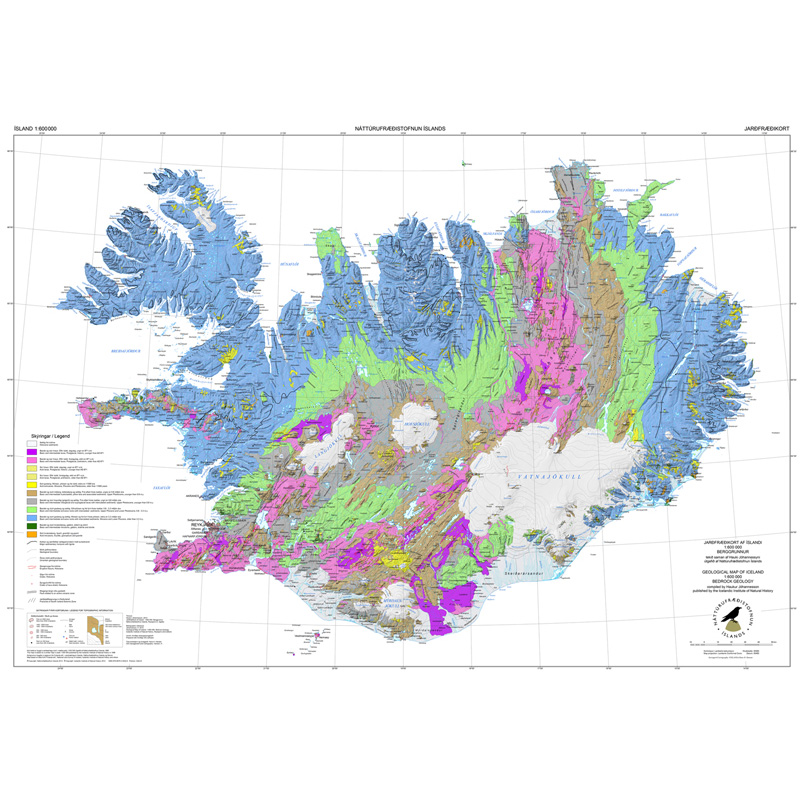geoscientificInformation
Type of resources
Available actions
Topics
Keywords
Contact for the resource
Provided by
Years
Formats
Representation types
Update frequencies
status
Scale
Resolution
-

Gagnasett sem sýnir yfirlitsupplýsingar úr Borholugrunni Orkustofnunar um borholur á Íslandi. Fram koma meðal annars: auðkennisnúmer borholu, borholunafn, staðarheiti, bortími, dýpi, sveitarfélag, eldra hreppsnafn, landnúmer, tilgangur og tegund borunar, bor og borfyrirtæki, staðsetningarhnit í ISN93 og WGS84, gæði hnita, fóðringardýpi og holuvídd. Í töflunni eru yfir 15.000 færslur. Upplýsingar úr gagnatöflunni eru bæði aðgengilegar á vefsíðu OS og í Kortasjá OS.
-
The dataset presents three layers of geothermal data from Iceland based on "Atlas of Geothermal Resources in Europe" (2002). Heat-flow density, Temperature at 1000 meters and Temperature at 2000 meters (1:10 000 000).
-

Íslenskur jarðvegur telst til eldfjallajarðar (Andosol) að langmestum hluta, en eldfjallajörð er jarðvegur sem myndast á eldvirkum svæðum heimsins. Eldfjallajörð hefur afar sérstæða eiginleika sem greina hana frá öðrum jarðvegsgerðum. Útbúin var einföld flokkun fyrir íslenskan jarðveg, sem m.a. byggist á alþjóðlegum flokkunarkerfum en einnig á vinnu Björns Jóhannessonar og Þorsteins Guðmundssonar. Flokkunin gerir greinarmun á i) jarðvegi auðna (glerjörð sem skiptist í melajörð, malarjörð, sandjörð og vikurjörð; ii) jarðvegi gróins lands með sortueiginleika (sortujörð, sem skiptist í brúnjörð, votjörð og svartjörð), iii) lífrænni mójörð og að síðustu iv) öðrum jarðvegi sem er margvíslegur að gerð. Í síðasta flokknum er bergjörð útbreiddust, en auk þess má nefna frerajörð sífrerasvæða og kalkjörð. Jarðvegskortið var unnið á grundvelli sniða og jarðvegssýna sem safnað hefur verið víða um landið. Kortið er á vektora formi og í mælikvarða 1:500 000. Það er m.a. hluti evrópska jarðvegskortsins. A soil map of Iceland: The Soil map classification separates between; 1) andic soils, which are Brown Andosols, Gleyic Andosols and Histic Andosols; 2) Vitrisols, soils of deserts, which are divided into Cambic Vitrisols, Gravelly Vitrisols, Arenic Vitrisols and Pumice Vitrisols iii) Histosols, and iv) other soil types such as Cryosols and Leptosols. The classification system is in part based on WRB system and Soil Taxonomy and earlier work by Björn Jóhannesson and Þorsteinn Guðmundsson (see English Summary and 1. table in http://www.moldin.net/uploads/3/9/3/3/39332633/jardvegskort_2.pdf). The map is in a coarse scale (1:500 000) and is not intended to use for particular points on the landscape. It is rather an overview. It has been incorporated into the EU soil database and the Circumpolar soil map.
-

Gagnasafn (GDB) NI_J600v_hoggun: Jarðfræðikorti af Íslandi – Höggun – 1:600.000 [Geological Map of Iceland – Tectonics – 1:600.000]. Höggunarkort af Íslandi sýnir jarðfræði landsins á nýstárlegan hátt. Jarðlög eru flokkuð eftir aldri en ekki eftir gerð og samsetningu. Sýnd eru eldstöðvakerfi, þ.e. megineldstöðvar, sprungu- og gangareinar, bæði virkar og útkulnaðar. Einnig eru sýnd helstu brotakerfi landsins og halli jarðlaga. Kortið gefur innsýn í jarðfræðilega byggingu landsins. [The Tectonic Map of Iceland gives a new view of the country's geology. The rocks are classified by age, but not by type or composition. Volcanic systems including central volcanoes, fissures and dyke swarms, both active and extinct, are shown, as are the island's principal fracture zones and the dip of rock layers. The map thus gives a useful insight into the geological structure of the country.]
-

Gagnasafn (GDB) NI_J600v_berg_2.utg: Jarðfræðikorti af Íslandi – Berggrunnur – 1:600.000 [Geological Map of Iceland – Bedrock geology – 1:600.000]. Berggrunnskort af Íslandi sýnir stærstu drættina í jarðfræði landsins. Jarðlög eru flokkuð eftir aldri, gerð og samsetningu. Kortið sýnir vel gosbelti landsins og dreifingu gossstöðva frá nútíma. Nútímahraunum er skipt í forsöguleg og söguleg hraun (yngri en 871 e. Kr. ). [The Geological Map of Iceland shows the main features of the bedrock geology. Formation are classified by age, type, and composition. The map clearly shows the island's volcanic zones and the distribution of the recent eruption sites. Lava fields of the Holocene are shown as pre-historic or historic (younger than AD 871].]
-

not_specified
-

Aurora Geosciences Ltd was contracted to perform a review of publicly available digital magnetic geophysical data submitted with assessment reports to develop standardized products and compilations. Data submitted prior to March 2015 were considered. Individual assessment report data were levelled and integrated with 1:250000 compilations. Four gridded PDFs have been produced (residual total magnetic field, reduced to pole, vertical derivative and tilt derivative). Original 250k geophysical data can be found in YGS Open File 2017-10.
-

This aeromagnetic survey was carried out by Geo Data Solutions GDS Inc. from January 12, 2018 to March 16, 2018. The data were recorded using split-beam cesium vapour magnetometers mounted in the tail booms of a Beechcraft King Air and a Piper Navajo. The nominal traverse and control line spacings were 400 m and 2400 m, and the aircraft flew at a nominal terrain clearance of 150 m. Travers lines were oriented N45°E with orthogonal control lines.
-

Aurora Geosciences Ltd was contracted to perform a review of publicly available digital magnetic geophysical data submitted with assessment reports to develop standardized products and compilations. Data submitted prior to March 2015 were considered. Individual assessment report data were levelled and integrated with 1:250 000 compilations. Four gridded PDFs have been produced (residual total magnetic field, reduced to pole, vertical derivative and tilt derivative). Original 250k geophysical data can be found in YGS Open File 2017-17.
-

This map of the total magnetic field was derived from data acquired during an aeromagnetic survey carried out by EON Geosciences Inc. in the period between April 10, 2009 and September 16, 2009. The data were recorded using split-beam cesium vapour magnetometers (sensitivity =0.005 nT) mounted in each of the tail booms of a Piper Navajo and a Cessna 206 aircraft. The nominal traverse and control line spacings were, respectively, 800 m and 2 400 m, and the aircraft flew at a nominal terrain clearance of 250 m. Traverse lines were oriented N90°E with orthogonal control lines. The flight path was recovered following post-flight differential corrections to the raw Global Positioning System data and inspection of ground images recorded by a vertically-mounted video camera. The survey was flown on a pre-determined flight surface to minimize differences in magnetic values at the intersections of control and traverse lines. These differences were computer-analysed to obtain a mutually levelled set of flight-line magnetic data. The levelled values were then interpolated to a 200 m grid. The International Geomagnetic Reference Field (IGRF) was not removed from the magnetic field.
 Arctic SDI catalogue
Arctic SDI catalogue